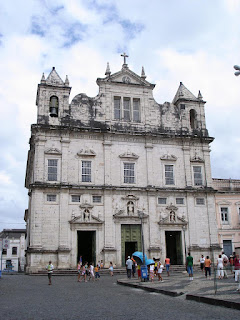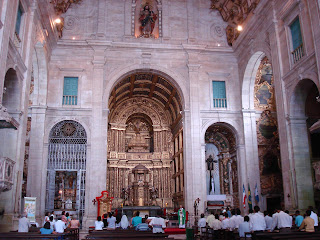Thursday, April 30th, 2009
Catedral Basílica de Salvador
Next time I am in Brazil, I want to go to Salvador and visit the city’s Cathedral Basilica. This cathedral was built between 1657 and 1672; originally, it was part of the Jesuit College in Salvador. All I can say is, those Jesuits sure know how to construct an awesome building.
 My two favorite things on the facade are the ginormous volute scrolls between the two bell towers. So awesome! I also love all of the broken (Baroque-en!) pediments that decorate the tops of the windows. The three statues that cover the portals are the saints Ignacio, Francisco de Borja and Francisco Xavier.
My two favorite things on the facade are the ginormous volute scrolls between the two bell towers. So awesome! I also love all of the broken (Baroque-en!) pediments that decorate the tops of the windows. The three statues that cover the portals are the saints Ignacio, Francisco de Borja and Francisco Xavier. Nave facing the shallow capela-mor and side altars. It is possible that the statue of Christ (above the main altar) is the largest wooden statue in Brazil.
Nave facing the shallow capela-mor and side altars. It is possible that the statue of Christ (above the main altar) is the largest wooden statue in Brazil.
I’m still doing research on this cathedral, particularly to verify a few things. I read online that the interior carvings were performed by slaves, and some of the altarpieces are decorated with Candomblé symbols.1 As of yet, I haven’t found any printed or scholarly material that supports this idea. But it’s interesting and entirely possible; I’ll add something in the comment section of this post if I ever find more information. Maybe I’ll just have to fly down to Brazil and examine the altars myself…
1 Candomblé is a religion-philosophy that is concentrated in Salvador. It has roots in African mysticism but also has been influenced by Catholicism (largely because African slaves were adopted/forced into the Catholic church by their owners). There are many similarities between the African deities and Catholic saints.


Wow, beautiful. It never ceases to amaze me at the skill and talent of the “lower status” citizens. Truly slaves were artists.
“Baroque-en,” hee hee.
Say, as I was reading this interesting piece I thought (unrelatedly), I wonder if Monica will post something on Gaudi. Do you know much about him and his work? Some day I’d love to go to Spain and see some.
Yeah, I’d love to do a post of Gaudi. Good idea. I’ll do one soon, e.
M: yay!